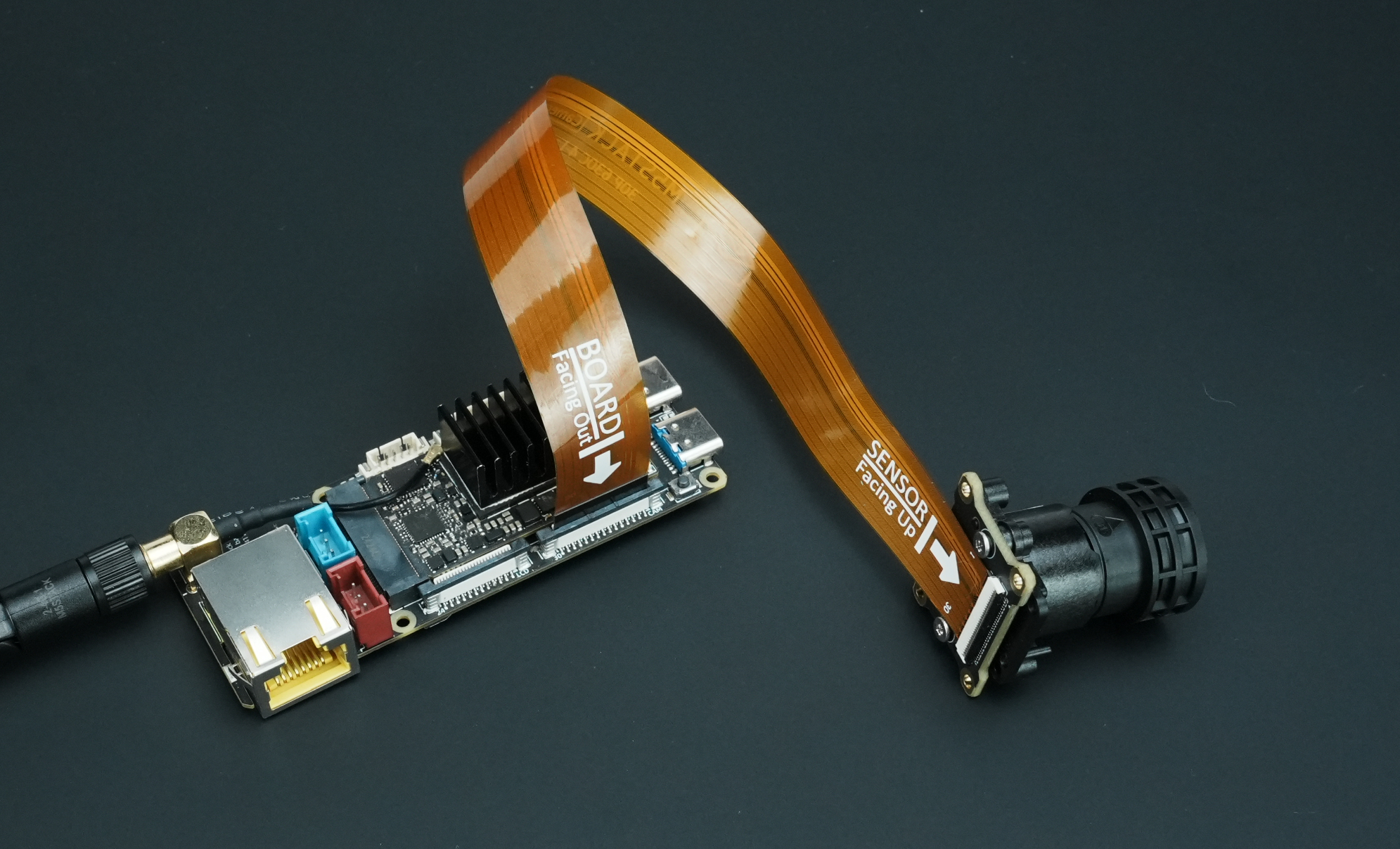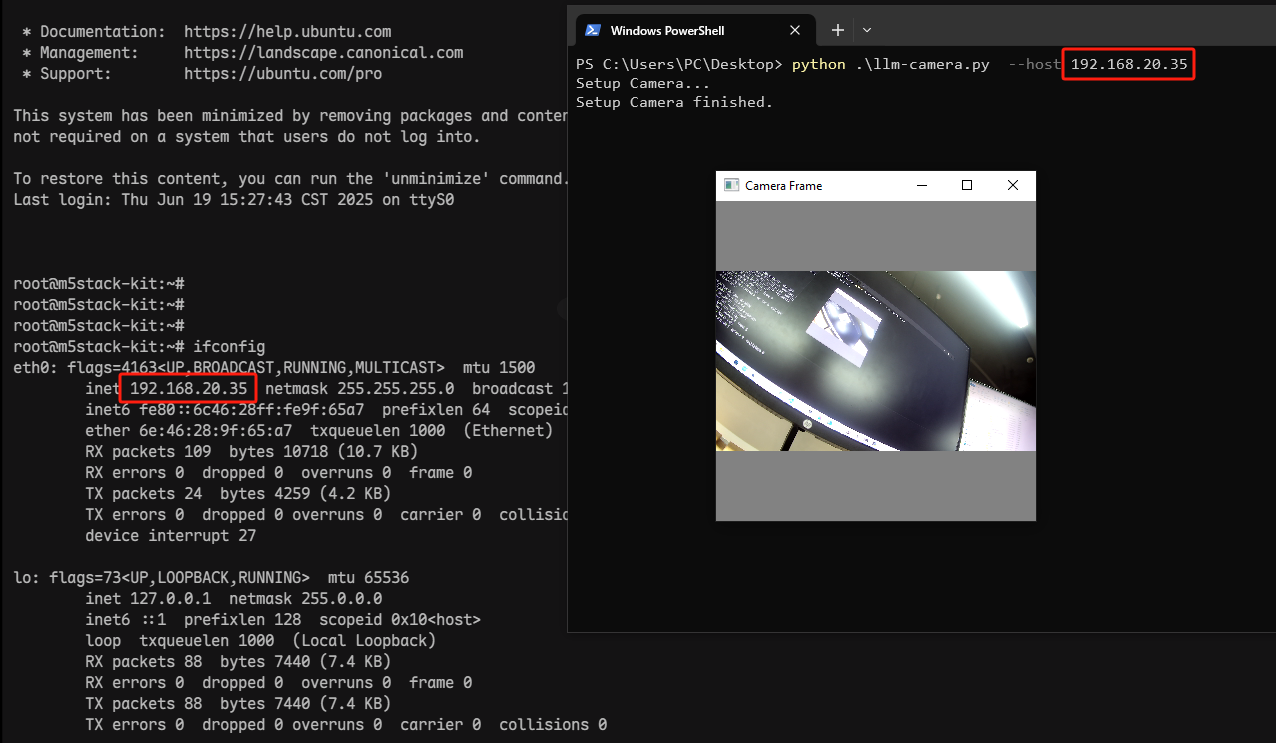LLM630 Compute Kit - StackFlow API Camera Demo
This example demonstrates how to access and display camera data via StackFlow API by running a script on a PC.
1. Preparation
- Before powering on the device, connect the CamModule SC850SL camera to the LLM630 Compute Kit via an FPC cable, as shown below:

Refer to the LLM630 Compute Kit UART / ADB / SSH Debugging Guide to learn how to configure networking and file transfers, and obtain the device IP address.
Follow the LLM630 Compute Kit Software Package Update Tutorial to install the following package:
apt install llm-camera2. Client Script
Download the client test script and make sure your PC is on the same network as the LLM630 Compute Kit. On the PC, install the opencv-python dependency using pip:
pip install opencv-pythonpip install opencv-python -i https://mirrors.aliyun.com/pypi/simple # For Chinese usersCopy the script below and run it with the actual device IP address:
python llm-camera.py --host 192.168.20.24import socket
import json
import argparse
import base64
import numpy as np
import cv2
import time
def create_tcp_connection(host, port):
sock = socket.socket(socket.AF_INET, socket.SOCK_STREAM)
sock.connect((host, port))
return sock
def send_json(sock, data):
json_data = json.dumps(data, ensure_ascii=False) + '\n'
sock.sendall(json_data.encode('utf-8'))
recv_buffer = ""
def receive_response(sock):
global recv_buffer
while '\n' not in recv_buffer:
part = sock.recv(4096).decode('utf-8')
if not part:
break
recv_buffer += part
if '\n' in recv_buffer:
line, recv_buffer = recv_buffer.split('\n', 1)
return line.strip()
else:
line, recv_buffer = recv_buffer, ""
return line.strip()
def close_connection(sock):
if sock:
sock.close()
def create_init_data(response_format, deivce, enoutput, frame_height, frame_width, enable_webstream, rtsp):
return {
"request_id": "camera_001",
"work_id": "camera",
"action": "setup",
"object": "camera.setup",
"data": {
"response_format": "image.yuvraw.base64" if response_format =="yuv" else "image.jpeg.base64",
"input": deivce,
"enoutput": enoutput,
"frame_width": frame_width,
"frame_height": frame_height,
"enable_webstream": enable_webstream,
"VinParam.bAiispEnable": 0,
"rtsp": "rtsp.1280x720.h265" if rtsp == "h265" else "rtsp.1280x720.h264",
}
}
def parse_setup_response(response_data, sent_request_id):
error = response_data.get('error')
request_id = response_data.get('request_id')
if request_id != sent_request_id:
print(f"Request ID mismatch: sent {sent_request_id}, received {request_id}")
return None
if error and error.get('code') != 0:
print(f"Error Code: {error['code']}, Message: {error['message']}")
return None
return response_data.get('work_id')
def reset(sock):
sent_request_id = 'reset_000'
reset_data = {
"request_id": sent_request_id,
"work_id": "sys",
"action": "reset"
}
ping_data = {
"request_id": "ping_000",
"work_id": "sys",
"action": "ping"
}
send_json(sock, reset_data)
while True:
try:
send_json(sock, ping_data)
time.sleep(1)
except (BrokenPipeError, ConnectionResetError, OSError) as e:
return
def setup(sock, init_data):
sent_request_id = init_data['request_id']
send_json(sock, init_data)
response = receive_response(sock)
response_data = json.loads(response)
return parse_setup_response(response_data, sent_request_id)
def exit_session(sock, deinit_data):
send_json(sock, deinit_data)
print("Exit")
def parse_inference_response(response_data):
error = response_data.get('error')
if error and error.get('code') != 0:
print(f"Error Code: {error['code']}, Message: {error['message']}")
return None
return response_data.get('data')
def main(args):
sock = create_tcp_connection(args.host, args.port)
frame_width, frame_height = args.imgsz
try:
print("Reset...")
reset(sock)
close_connection(sock)
sock = create_tcp_connection(args.host, args.port)
print("Setup Camera...")
init_data = create_init_data(
response_format = args.format,
enoutput=args.enoutput,
deivce=args.device,
frame_height=frame_height,
frame_width=frame_width,
enable_webstream=args.webstream,
rtsp=args.rtsp
)
camera_work_id = setup(sock, init_data)
print("Setup Camera finished.")
while True:
response = receive_response(sock)
if not response:
continue
response_data = json.loads(response)
data = parse_inference_response(response_data)
if data is None:
break
decoded = base64.b64decode(data)
if args.format == "yuv":
yuv_frame = np.frombuffer(decoded, dtype=np.uint8).reshape((frame_height, frame_width, 2))
bgr_frame = cv2.cvtColor(yuv_frame, cv2.COLOR_YUV2BGR_YUY2)
else:
jpg_array = np.frombuffer(decoded, dtype=np.uint8)
bgr_frame = cv2.imdecode(jpg_array, cv2.IMREAD_COLOR)
cv2.imshow("Camera Frame", bgr_frame)
if cv2.waitKey(1) & 0xFF == ord('q'):
break
exit_session(sock, {
"request_id": "camera_exit",
"work_id": camera_work_id,
"action": "exit"
})
time.sleep(3) # Allow time for the exit command to be processed
finally:
close_connection(sock)
if __name__ == "__main__":
parser = argparse.ArgumentParser(description="TCP Client to send JSON data.")
parser.add_argument("--host", type=str, default="localhost", help="Server hostname (default: localhost)")
parser.add_argument("--port", type=int, default=10001, help="Server port (default: 10001)")
parser.add_argument("--device", type=str, default="axera_single_sc850sl", help="Camera name, i.e. axera_single_sc850sl or /dev/video0")
parser.add_argument("--enoutput", type=bool, default=True, help="Whether to output image data")
parser.add_argument("--format", "--output-format", type=str, default="jpeg", help="Output image data format, i.e. jpeg or yuv")
parser.add_argument("--imgsz", "--img", "--img-size", nargs="+", type=int, default=[320, 320], help="image (h, w)")
parser.add_argument("--webstream", action="store_true", help="Enable webstream")
parser.add_argument("--rtsp", default="h264", help="rtsp output, i.e. h264 or h265")
args = parser.parse_args()
main(args)Parameter Explanation
- host: IP address of the LLM630 Compute Kit
- port: TCP port (default: 10001)
- device: Camera name, e.g.
'axera_single_sc850sl'for MIPI CSI camera, or e.g.'/dev/video0'for USB camera - enoutput: Whether to output image data (default: true)
- format: Output image format (
jpegby default, oryuv) - imgsz: Image size (default: 320x320, e.g. 480x480)
- webstream: Whether to enable web stream (default: off); when enabled, access via
http://IP:8989/ - rtsp: RTSP video encoding format (
h264by default, orh265)
3. Start Interaction
The PC will display the camera video feed as shown below. Press the “q” key to exit.

